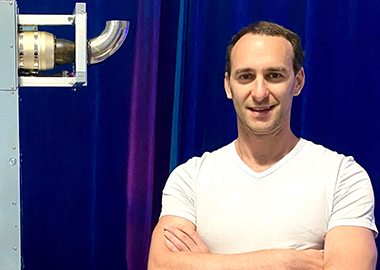FusionFlight builds Jet-Powered Vertical Take-off and Landing aircraft. These aircraft are based on the JetQuad platform which consists of four jet- engines each equipped with a proprietary Thrust-Vectoring System. The innovative platform allows for precision take-off and landing as well as single-point hover and high-speed cruise. The platform is simple, affordable and has no external airfoils making it resilient to adverse weather conditions and operation in high altitudes. When it comes to human life, speed is key, and aircraft based on the JetQuad technology is set to completely revolutionize emergency medical delivery as well as rapid human evacuation.
When considering medical evacuation, excessive blood-loss is the largest contributor to fatalities, especially tosoldiers in the field. Injured personnel must rely on the standard form of aerial Medical Evacuation (Medevac) – the helicopter –an expensive and unreliable machine that endangers not only the lives of the injured but also the lives of pilots. According to the “golden hour rule”, the Medevac must deliver the injured to the field hospital within one hour, otherwise their chances of survival are significantly reduced. Most times, the slow helicopter cannot meet this rule and its large rotors prohibit it from performing rescue operations in high-altitudes or dense terrain. Clearly, there is a significant opportunity to produce a “Golden-Hour Medevac” – a compact and affordable machine that can evacuate injured personnel at very high speeds.
FusionFlightis currently working on the AB7 JetQuad –the “Flying Stretcher”. This device has the landing footprint of a human stretcher and is powered by eight microturbine jet-engines. It may be refueled by any heavy fuel in minutes (Jet-A, Kerosene, Diesel). The AB7 is controlled by individual thrust-vectoring systems allowing for precision hover, all- terrain VTOL operations, and high-speed cruise (250mph+) to a range of 60-miles. The system is easy to maintain and costs about $400k/unit. The turbines are integrated with generators for supplying power to various accessories such as blood transfusion pumps, pressurization equipment, and scanners. In a typical mission profile, the AB7 can carry supplies in-route to the pick-up location and then carry the injured person on the way back to the hospital. The injured person is automatically scanned by the AB7 during flight so that by the time the individual arrives at the hospital, the EMT knows exactly what procedures need to be performed. Most importantly, the AB7 JetQuad is based on flight-proven technology, the AB5 JetQuad – a half-scale technological demonstrator that has successfully flown in October of 2019.
This half-scale technology demonstrator also has very interesting capabilities. It is essentially a Vertical Take-off and Landing (VTOL), High-speed, Unmanned Aerial System (UAS). It is particularly useful for emergency medical deliveries (which require high speed) in environments inaccessible by ordinary aircraft. Potential applications include delivery in high-altitudes, ship-to-shore, and third world countries that have poor infrastructure. It is currently estimated that the medical drone delivery market will be worth close to $1B by year 2025. FusionFlight intends to dominate a vast portion of this market by offering an affordable ($100k for base model) UAS, that can delivery emergency medical supplies and blood faster than any other compact VTOL drone.
Alex Taits (CEO) has founded FusionFlight in 2016 and develops the JetQuad technology out of his garage in Dallas, Texas.


-page-001.jpg)